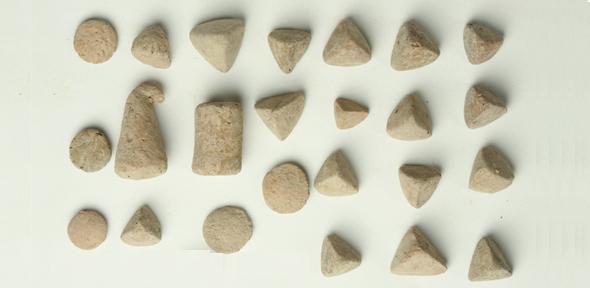Neo-Assyrian Information Technology
La préhistoire en Lorraine :: Palabres autour du feu :: Sujets divers et variés :: Archéo (encore et toujours)
Page 1 sur 1
 Neo-Assyrian Information Technology
Neo-Assyrian Information Technology
Neo-Assyrian Information Technology
Monday, July 14, 2014

(Ziyaret Tepe Archaeological Project)
CAMBRIDGE, ENGLAND—Excavations in southeastern Turkey, in the lower town of Tušhan, a provincial capital of the Neo-Assyrian Empire, have uncovered hundreds of clay tokens dating to the first millennium B.C. It had been thought that record-keeping with such tokens had been replaced with cuneiform two thousand years earlier, but these tokens were found in two rooms that may have served as a delivery area in an administrative building. “We think one of two things happened here. You either have information about livestock coming through here, or flocks of animals themselves. Each farmer of herder would have a bag with tokens to represent their flock,” John MacGinnis of the MacDonald Institute for Archaeological Research at the University of Cambridge told Science Daily. The information collected with the tokens would have been recorded onto cuneiform tablets somewhere else. “The tokens provided a system of moveable numbers that allowed for stock to be moved and accounts to be modified and updated without committing to writing; a system that doesn’t require everyone involved to be literate,” he explained. MacGinnis hopes that the codes of the token system will one day be fully understood.
http://www.archaeology.org/news/2303-140714-turkey-clay-tokens
Monday, July 14, 2014

(Ziyaret Tepe Archaeological Project)
CAMBRIDGE, ENGLAND—Excavations in southeastern Turkey, in the lower town of Tušhan, a provincial capital of the Neo-Assyrian Empire, have uncovered hundreds of clay tokens dating to the first millennium B.C. It had been thought that record-keeping with such tokens had been replaced with cuneiform two thousand years earlier, but these tokens were found in two rooms that may have served as a delivery area in an administrative building. “We think one of two things happened here. You either have information about livestock coming through here, or flocks of animals themselves. Each farmer of herder would have a bag with tokens to represent their flock,” John MacGinnis of the MacDonald Institute for Archaeological Research at the University of Cambridge told Science Daily. The information collected with the tokens would have been recorded onto cuneiform tablets somewhere else. “The tokens provided a system of moveable numbers that allowed for stock to be moved and accounts to be modified and updated without committing to writing; a system that doesn’t require everyone involved to be literate,” he explained. MacGinnis hopes that the codes of the token system will one day be fully understood.
http://www.archaeology.org/news/2303-140714-turkey-clay-tokens
 Sujets similaires
Sujets similaires» sites de survie sur le web
» Did Lower Testosterone Levels Correlate With Rise of Technology?
» Lettre d'information de la Socièté Préhistorique Française
» Did Lower Testosterone Levels Correlate With Rise of Technology?
» Lettre d'information de la Socièté Préhistorique Française
La préhistoire en Lorraine :: Palabres autour du feu :: Sujets divers et variés :: Archéo (encore et toujours)
Page 1 sur 1
Permission de ce forum:
Vous ne pouvez pas répondre aux sujets dans ce forum



» Animals in Mesolithic Burials in Europe
» Les objets de parure associés au dépôt funéraire mésolithique de Große Ofnet : implications pour la compréhension de l’organisation sociale des dernières sociétés de chasseurs-cueilleurs du Jura Souabe
» Les grands mammifères de la couche 5 de Mutzig I (Bas-Rhin). La subsistance au Paléolithique moyen en Alsace
» Aspects of faunal exploitation in the Middle Palaeolithic : evidence from Wallertheim (Rheinhessen, Germany)
» Middle Paleolithic subsistence in the central Rhine Valley
» Broadening and diversification of hunted resources, from the Late Palaeolithic to the Late Mesolithic, in the North and East of France and the bordering areas
» Les boules de loess d’Achenheim et les "Lihtte Mirr". Essai de paléo-ethnographie comparée
» Les galets tronqués à base plane des lœss de la terrasse de Hangenbieten
» Néolithique "initial"', néolithique ancien et néolithisation dans l'espace centre-européen : une vision rénovée